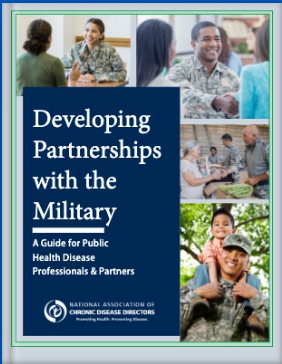Partnership Guide for Public Health Professionals
Step 3: Find Key Individuals
Readiness, Retention, and Recruitment
As you begin building relationships with your active duty local military, it is advantageous to understand what is important to them. This will help you frame public health issues and programming in a language that is familiar and appealing to them. Military priorities that align with public health practice can be easily remembered as the three R’s: Readiness, Retention, and Recruitment.
Readiness
Broadly defined, readiness refers to the forces’ ability to fight and meet the demands of their assigned missions. This includes maintaining equipment, frequent training for individuals and teams, and ensuring that military personnel and their families are ready for deployment. A Service member’s health status is an important component of readiness. As such, Individual Medical Readiness (IMR) is routinely assessed. While each service evaluates IMR differently, all include:
- A periodic health assessment
- A review of deployment-limiting conditions
- A dental readiness assessment
- An immunization readiness assessment
In the Total Force Fitness framework, IMR is one of eight components that influence readiness.
The others include Physical Fitness, Social Fitness, Psychological Fitness, Environmental Fitness, Nutritional Fitness, Financial Fitness, and Spiritual Fitness.
Families are key to readiness. A happy, healthy, and ready family enables the Service member to do their job. With less distractions and stress on the home front, military personnel are better able to perform their assigned missions efficiently, effectively, and safely.
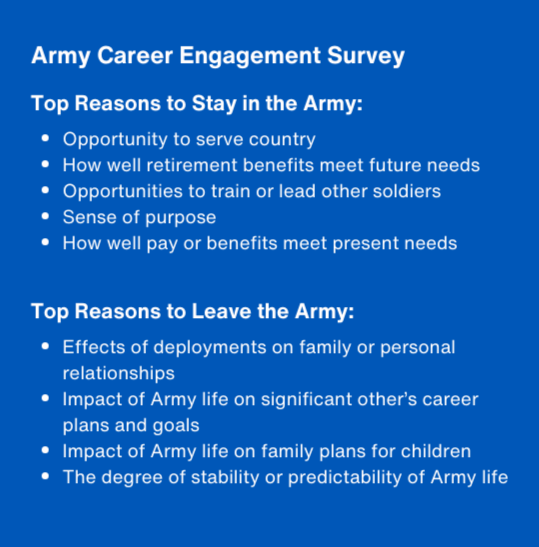 Retention
Retention
Retention refers to the rate at which military personnel voluntarily choose to stay in the military after their obligated term of service has ended. Retaining qualified personnel is essential to preserving the overall readiness of the force and avoids costs associated with training replacement personnel in essential skills.
In 2021, the Army launched the annual Department of Army Career Engagement Survey, which offers insight on why soldiers may choose to stay or leave service. While this survey only includes the Army, members from other services may have similar reasons.
Public Health professionals can support readiness and retention in several ways:
- Promote policy changes that make the communities around military installations healthier
- Expand eligibility of programs and services to military personnel and their families and perform targeted outreach to increase awareness of these programs among the military-connected
- Provide model policies or guidance on health promotion and disease prevention to military leadership
Recruitment
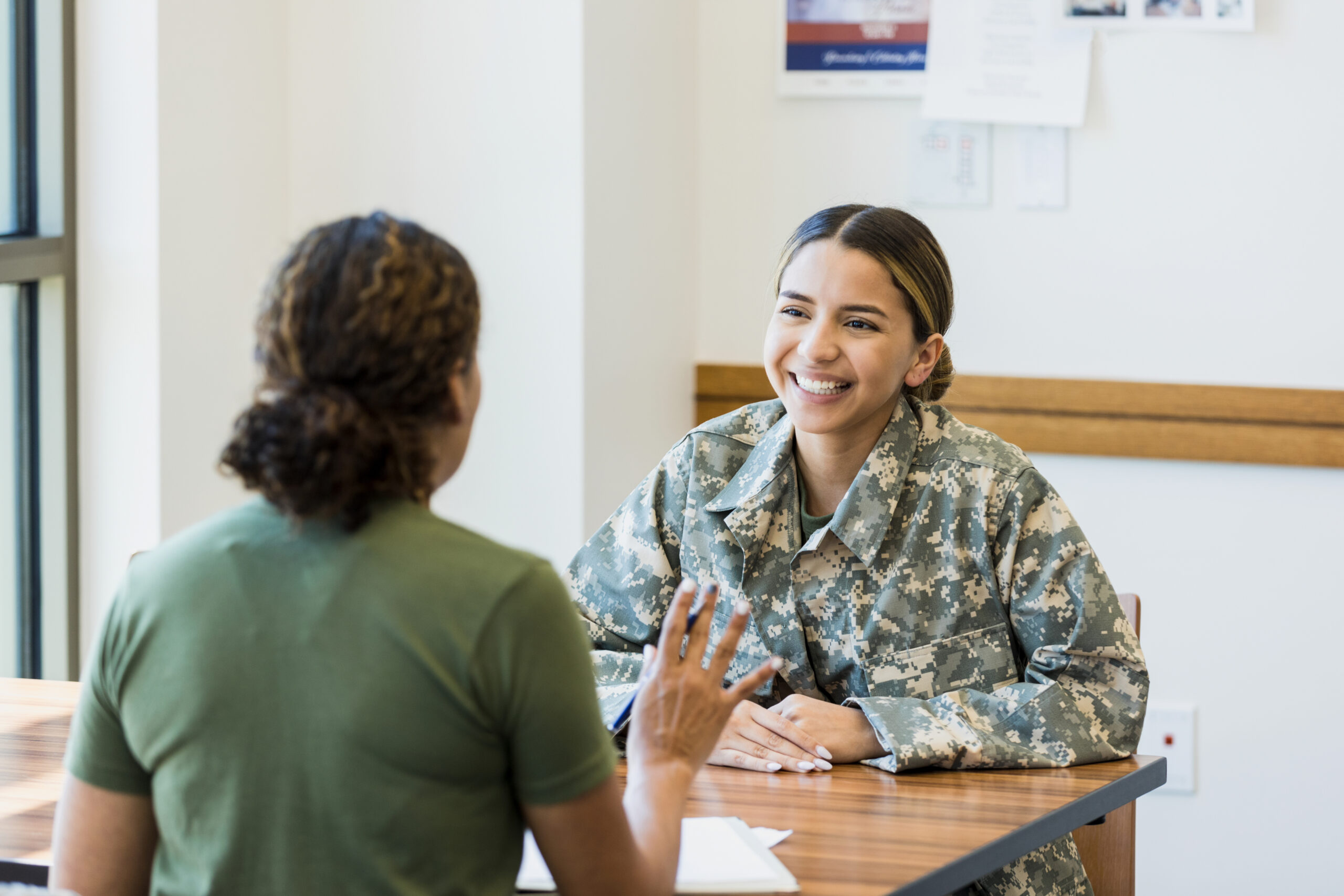 The United States boasts an all-volunteer military force. Changing demographics, a competitive labor market, and poorer health status of youth have negatively impacted recruiting efforts. Military leaders stated that 2022 was “the most difficult [recruiting period] since the end of the draft in 1973”
The United States boasts an all-volunteer military force. Changing demographics, a competitive labor market, and poorer health status of youth have negatively impacted recruiting efforts. Military leaders stated that 2022 was “the most difficult [recruiting period] since the end of the draft in 1973”
According to the Army, 71% of youth do not qualify for military service because of obesity, drugs, physical and mental health problems, misconduct, and aptitude. A 2023 study found that only 34% of the military-aged civilian population (aged 17-42) met the BMI and physical activity standards to qualify for service.
Public health professionals can support the armed forces’ recruiting efforts through policy and programmatic work aimed at improving the health of youth. Examples include improving nutrition and physical activity in daycare settings, promoting breastfeeding, and supporting tobacco-free policies.
Making Contact
Building connections can be one of the most challenging aspects of partnering with the military. It is not a straightforward process and can require significant research and persistence. This page provides recommendations for potential partners both off and on military installations and strategies to connect with them.
Military and Family Support Centers
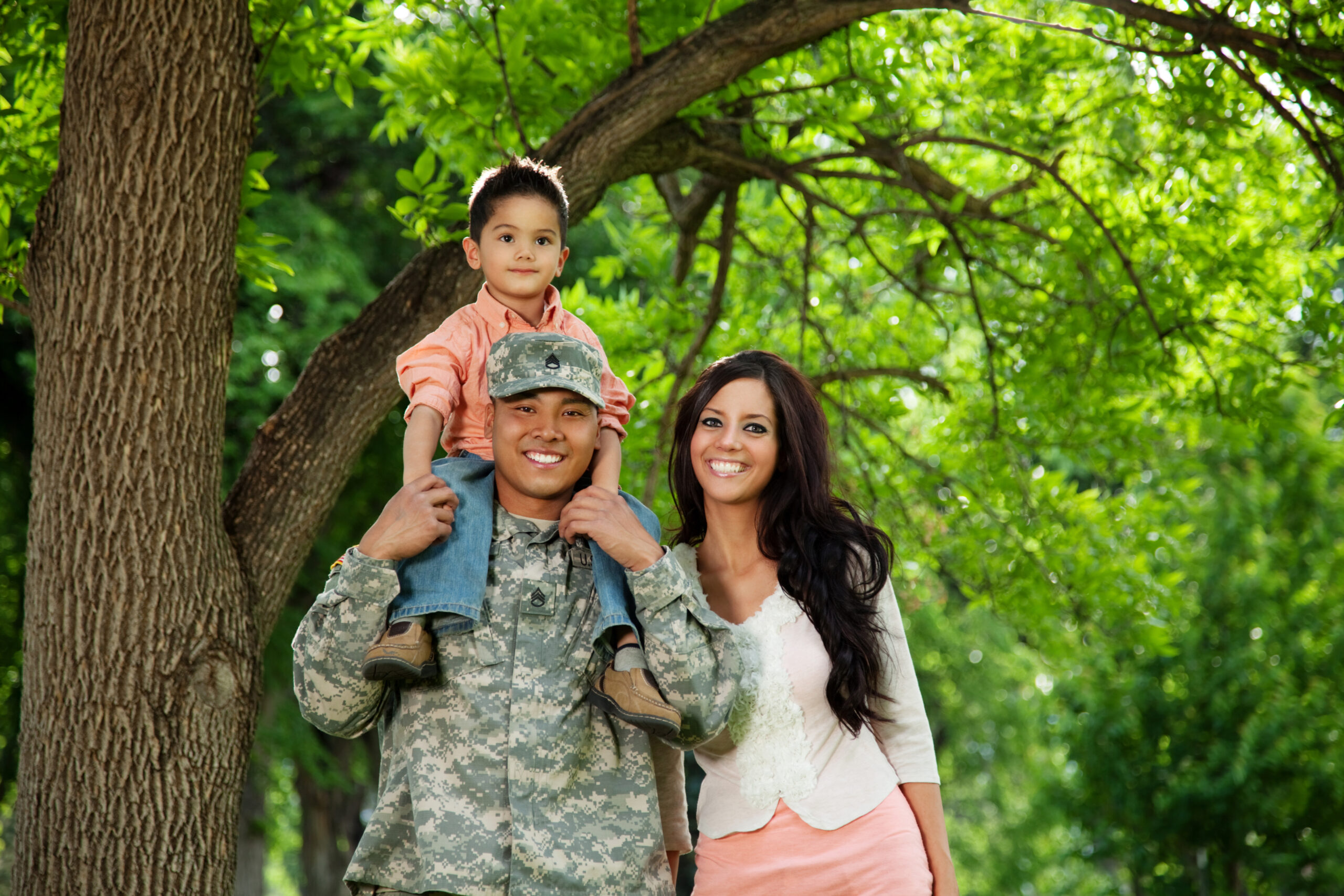 Most major active-duty installations have a Military and Family Support Center (M&FSC) that is open to all Service members and their families, regardless of the Service member’s branch. The M&FSCs serve as one-stop-shop information and referral centers. One of their major functions is making connections— ensuring military personnel and their families get linked to the appropriate services, both on and
off base.
Most major active-duty installations have a Military and Family Support Center (M&FSC) that is open to all Service members and their families, regardless of the Service member’s branch. The M&FSCs serve as one-stop-shop information and referral centers. One of their major functions is making connections— ensuring military personnel and their families get linked to the appropriate services, both on and
off base.
Public health can support military families, DoD civilians, and retirees working on military installations by partnering with M&FCs on:
- Policy changes on installations (e.g., tobacco-free buildings and grounds, tobacco pricing in marketplaces/exchanges, improved nutrition, and physical activity in DoD schools, decreased screentime in DoD day care settings, breastfeeding supports for lactating military personnel)
- Environmental changes in the surrounding communities (e.g., improved street design, pedestrian infrastructure, public transit infrastructure around military installations, nutrition environment improvements)
- Promoting evidence-based chronic disease prevention programs (e.g., Tobacco Quitlines, National Diabetes Prevention Program, Chronic Disease Self-Management Program)
- Providing health education and sharing resources at M&FC-sponsored events
- Including M&FC staff on public health workgroups and advisory boards.
To find and connect with a M&FC:
- Visit MilitaryINSTALLATIONS’s Military and Family Support Centers search page.
- Filter by your location, military installation, or zip code. (The search field does not recognize acronyms. Enter the full spellings of states and installations. For example, NAS Jacksonville should be entered as Naval Air Station Jacksonville.)
- Go to the website of the installation you want to connect with.
- On the installation’s website, look for the terms like the following to help you navigate to the correct program: readiness, support services, family readiness, newcomers, resources, information, referral. Most often, you will be able to find a phone number or an email address.
In addition to the M&FSCs, there are service-specific family readiness programs that might be open to partnership. These programs may or may not be embedded in an M&FC.
Family Readiness Support Assistant (FRSA): FRSAs assist commanders in their responsibilities to support soldier and family readiness. They also provide mentorship and training to the Soldier Family Readiness Group (SFRG) Leaders assigned to each brigade/battalion. FRSAs coordinate resources and training to ensure commands, SFRGs, and ultimately soldiers and families are as ready as possible for military life. To find a FRSA for Army National Guard, perform a web search with the name of your state plus “Soldier and Family Readiness Group.” For example, “Ohio Soldier and Family Readiness Group.” To find a FRSA for active duty, complete a similar search but include the brigade, battalion, or installation name plus “Soldier and Family Readiness Group.” For example, “188th Infantry Brigade Soldier Family Readiness Group.”
Family Programs Director/Coordinator: The Family Programs Director/Coordinator serves as the primary coordinating resource and provides unit and community-based services that foster the growth, development, and readiness of the Reserve soldiers and families assigned to the command. The Army Reserve provides a national directory for their Family Programs Directors and Coordinators. Select your state on the map to be directed to the contact information for your Family Programs Director/Coordinator.
Deployment Readiness Coordinator (DRC): Formerly called Family Readiness Officers (FRO), DRCs are assigned to each unit. They manage and coordinate all matters that relate to unit and family readiness. The nonprofit, MarineParents.com, provides a search tool to find DRC contact information. The tool allows you to search by unit name, Marine division, or primary base location. Once you’ve selected the desired unit, the DRC contact information can be found toward the bottom of the unit’s page.
Navy Family Ombudsman: Ombudsmen are Navy spouse volunteers, appointed by the commanding officer. They are information and referral specialists for families in the command and serve as the communication link between the commanding officer and families. The Navy provides a search tool to help locate Ombudsmen. NOTE: This is not a secure site. Your browser may require you to acknowledge a security warning before it lets you proceed to the site. Once you have passed the security warning, select your state on the map. This will open a message portal for you to send a message to the appropriate Ombudsman through the site’s messaging system.
Key Spouse (KS): The KS is a volunteer appointed by the commander to act as an official unit readiness representative. The KS serves as a trusted agent between unit leadership and families and supports airmen, guardians, and families with community information and referrals. NOTE: Not all squadrons have a Key Spouse Program. Perform a web search with the installation name and “key spouse” to see if your local installation participates in the program.
Ombudsman: Coast Guard Ombudsmen are the communication link between families and the command. They provide information and referral resources and serve as advocates for family members. The Coast Guard provides a messaging system to find and connect with the Ombudsmen assigned to different geographic areas.
Yellow Ribbon Reintegration Program
The Yellow Ribbon Reintegration Program (YRRP) is a DoD-wide effort to promote the wellbeing of Reserve and National Guard members, their families, and communities by connecting them with resources throughout the deployment cycle. Through Yellow Ribbon events, Service members and families connect with local resources before, during, and after deployments.
Reintegration during post-deployment is a critical time for members of the Reserve and National Guard, as they often live far from military installations and other members of their units. Public health can support these programs by ensuring that information about health and prevention programs and services are included as resources at these events.
To find the local event coordinators, visit the YRRP event search page. You can narrow your search to one component (e.g., Navy Reserve or Air National Guard) or you can search for all events in each state, regardless of component. The results page will list all upcoming events for that component or state. Click on one or more events to find the Event Contact. Email the Event Contact to inquire about including information about public health programs and services.
Military OneSource State Consultants
Military OneSource provides comprehensive information, referral, and assistance on every aspect of military life 24 hours a day, seven days a week to all component members of the Armed Forces, their family members, and survivors. Military OneSource State Consultants work with Service members, families, military leadership, and military and civilian service providers to make sure the needs of the military community are met. Specifically, they provide need-based information and referral services to improve the quality of life and readiness of Service members, their families, and survivors and network with local service providers to raise understanding of the military community’s needs.
Public health can partner with Military OneSource State Consultants to increase awareness of public health programs and services (e.g., tobacco cessation resources, National Diabetes Prevention Programs, Family Healthy Weight Programs, etc.). State Consultants also develop and execute state support plans to ensure broad awareness of Military OneSource and its resources. Public health can explore how to align their planning efforts to support their state’s Military OneSource state support plan. To connect with your State Consultant, call the national line at 800-342-9647.
Associations
Most of the services have a companion national professional association with state and local chapters. These associations primarily focus on professional development, education, and legislative advocacy, but there may be an opportunity to collaborate on quality of life or other readiness topics.
The Association of the United States Army (AUSA) is a nonprofit educational and professional development association serving America’s Army and supporters of a strong national defense. AUSA provides a voice for the Army, supports the soldier, and honors those who have served. Find chapters by country or state on their Find A Chapter page.
The Surface Navy Association is a nonprofit that promotes greater coordination and communication among those who share a common interest in surface warfare (e.g., military, business, and academic communities). They provide members with programs and activities that enable professional growth, personal satisfaction, and camaraderie. Find Chapters by region on their Find Your Chapter page.
The Air and Space Forces Association advocates to lawmakers on issues affecting the Air and Space Forces, promotes aerospace and science, technology, engineering, & mathematics (STEM) education, supports professional development, and aids with wounded airmen. Find contact information for your local chapter on their Chapters & Field Leaders search page.
The Marine Corps Association is a member-based organization dedicated to professional development, recognition of excellence, and building recognition for the traditions and history of the Marine Corps. Their non-profit arm supports Marines through programs to promote professional military education. They do not have state or local chapters.
The National Guard Association of the United States partners with their state associations and congressional delegations to advocate for readiness, modernization, and quality of life for National Guard Members. Find contact information for your state, territorial, or district association on the State Association Directory.
Recruiting Commands
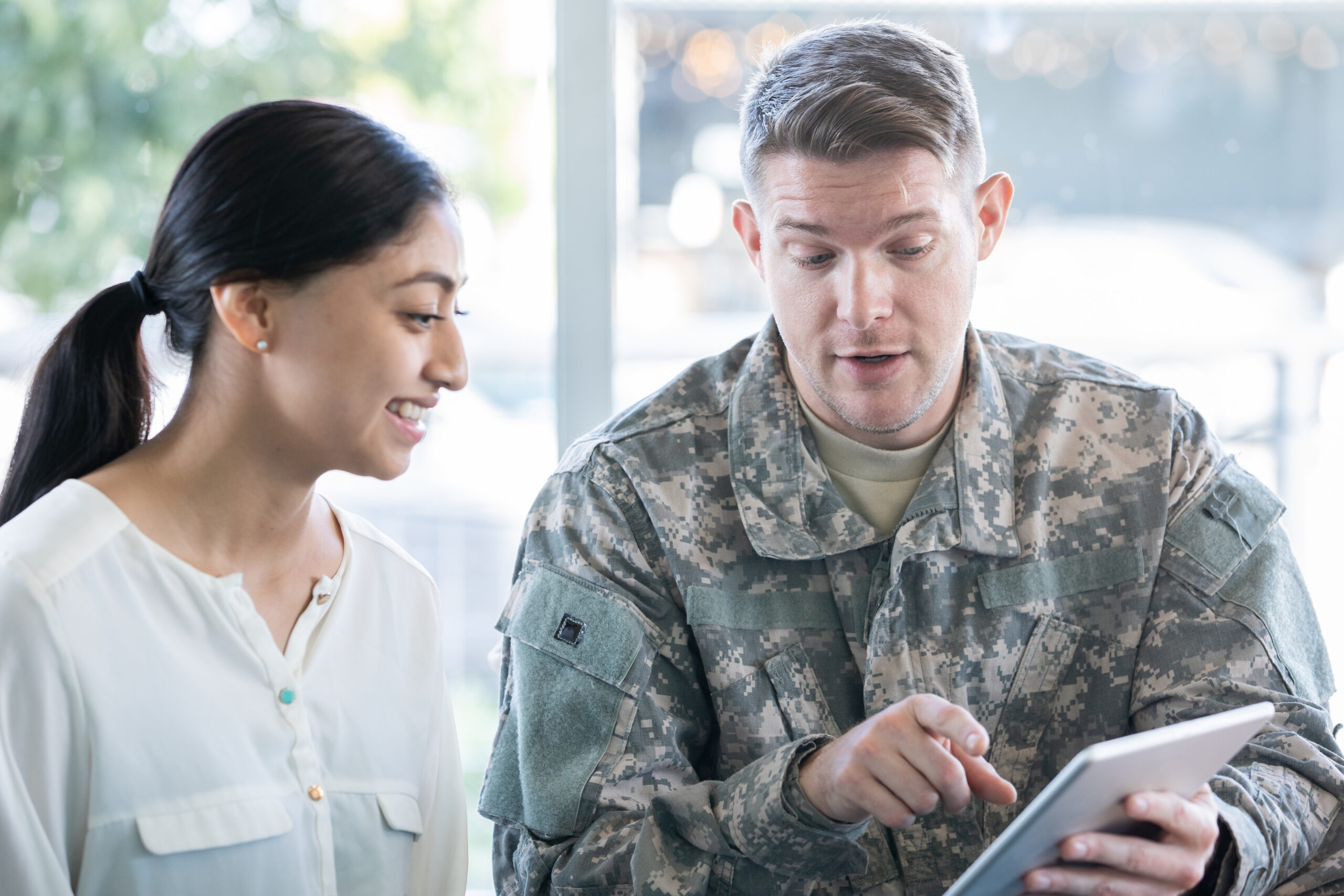 Military recruiters provide information about military service, career opportunities, and training to people who are interested in joining the military. Recruiters perform an array of duties including interviewing, screening, testing, and counseling possible candidates. They also can host events or create programs to help candidates get ready for boot camp. As such, recruiters are ideal outlets to increase awareness about public health programs and projects that can affect a potential recruit’s readiness for service (e.g., physical activity and nutrition programs, tobacco cessation).
Military recruiters provide information about military service, career opportunities, and training to people who are interested in joining the military. Recruiters perform an array of duties including interviewing, screening, testing, and counseling possible candidates. They also can host events or create programs to help candidates get ready for boot camp. As such, recruiters are ideal outlets to increase awareness about public health programs and projects that can affect a potential recruit’s readiness for service (e.g., physical activity and nutrition programs, tobacco cessation).
Recruiters are stationed in virtually every community. While it may make sense to work with individual recruiters for some activities, it may save time to initiate partnerships at a higher organizational level. The recommended organizational levels and tips for reaching out are outlined below.
As the largest force, the Army has a significant recruiting presence throughout the states and territories. It organizes its recruiting efforts by brigades that span multiple states. Within those brigades are battalions. Battalions align somewhat with state lines and may be the ideal level for first contact.
To identify your recruiting battalion, find your geographic area on this map. Once you’ve identified your brigade, click on the corresponding top-level bolded brigade name below the map (e.g., 6th BDE, 3rd BDE). Contacts for the region are listed in the righthand navigation bar. Ideal first contacts include Civil/Public Affairs (S5), Communications (S6), Recruiting/Master Trainers, or Executive Officers. If contacts for those are not available, look for Operations or S3.
The Navy organizes its recruiting activities into regional Navy Talent Acquisition Groups (NTAG). Locate the NTAG for your region on the Navy’s Locate a Coordinator page. From there, navigate to your geographic region. The list of contacts for your region is at the bottom of the page. Ideal first contacts include the Public Affairs Department, Chief Recruiter, or the Leads/ Marketing Department.
Identify your recruiting district on the US Marine Corps Recruiting Districts map, and then navigate to your district from the Marine Corps Recruiting Command Units webpage. Some units have contact information readily available on their website; however, most units do not. It may take more research to find contacts. Look for contact information for Marketing & Public Affairs.
The Air Force organizes its recruiting activities in Recruiting Groups and Recruiting Squadrons. Find the Recruiting Groups/Squadron for your geographic region on the Air Force Recruiting Service webpage. Navigate to your Group or Squadron and look for contacts in Marketing.
There are fewer recruiting personnel for the Coast Guard and Space Force. As a result, they cover more territory. For these services, it may be more practical to approach individual offices to develop partnerships. For the Coast Guard, search by state or zip code to find your recruiting office on their Find A Recruiter page. When you contact the office, ask for the Recruiter in Charge (RIC).
For Space Force, scroll to the bottom of their recruiting webpage. In the bottom right corner, search for a recruiter by zip code.
State Adjutant Generals (TAG)
Each state, the District of Columbia, and territory has a senior military official for the National Guard called the state adjutant general. This officer is known as TAG (The Adjutant General). TAGs are subordinate to state governors unless they have been federalized by the President to support foreign wars. As senior officials, TAGs may be difficult to establish partnerships with. We recommend that a senior health department official take responsibility for the initial contact. To locate a state TAG, perform a web search for your territory or state and “The Adjutant General.”
Defense-State Regional Liaison
The Defense-State Liaison Office (DSLO) works with state leaders across the country who are concerned with the welfare of Service members and military families living in their state. DSLO works with state leaders on key quality of life issues. The office employs eight regional liaisons who are knowledgeable about military issues and the policymaking process.
The DSLO has helped state policymakers enact more than 800 bills in the past 10 years covering licensure and employment protection, consumer protection, family law, childcare and child protection, voting, education, health care, state judicial systems, and other issues that matter to military families. You can contact DSLO through their State Policymakers Inquiry Form.
Community Veterans Engagement Boards
Community Veterans Engagement Board (CVEB) is a general term given by the U.S. Veteran’s Administration (VA) to local, grassroots veterans coalitions. The goal of CVEBs is to maximize the collective impact of local services, stakeholders, and federal/state/municipal agencies working to improve veteran outcomes. The VA provides subject matter expertise to CVEBs, as needed or requested.
CVEBs are locally controlled and have different capacities and projects. However, most do the following:
- Communicate with outreach programs and understand their goals
- Participate in local events
- Be a known partner within the community
- Host events, training, town-halls, and seminars
- Meet with leaders and influencers in the local community
- Promote/support VA services/events/programs
- Identify/develop mechanisms to reach veterans (different demographics may prefer different mechanisms such as social media and hardcopy newsletters)
State and Local Veterans Advisory Boards
Many states, counties, parishes, and cities have veteran advisory boards. Common roles for these boards include:
- Advising elected officials on issues of importance to military members, veterans and their families, legislative proposals, and veteran program operations
- Communicating with various groups relative to veteran’s issues
- Promoting veterans’-related events and functions
- Maintaining collaborative relationships between the government and military installation leadership
To see if your state or community has an advisory board, perform a web search for your community or state and “Veteran Advisory Board.”
Veterans Service Organizations
Veterans Service Organizations (VSO) offer a range of services for veterans, service members, dependents, and survivors. VSOs differ in their offerings. Some provide programming and services while others fundraise. Most VSOs also help veterans navigate their VA benefits. There are over 100 VA-recognized, national VSOs.
The VA works most closely with the following VSOs:
American Legion is committed to supporting veterans through local community programs. They operate over 10,000 posts and, as the largest VSO, support over 2.3 million members. They are organized by Departments (states) and local districts (posts). Search the list of their locations for local leadership.
American Veterans (AMVETS)‘s mission is to enhance and safeguard the entitlements for all American veterans who have served honorably and to improve the quality of life for them, their families, and the communities where they live through leadership, advocacy, and services. Search their chapter listing to find one of their 1,400 locations throughout the country.
Disabled American Veterans supports disabled veterans of all generations and their families by empowering them to lead high-quality lives with respect and dignity. In addition to disability claims support and their chapters, they provide more than 700,000 rides for veterans attending medical appointments. Find a local chapter on their search page.
Paralyzed Veterans of America’s mission is to change lives and build brighter futures for seriously injured veterans. They are dedicated to serving veterans, medical research, and civil rights for people with disabilities. Find information for their 72 national service offices and 32 chapters on their search page.
Veterans of Foreign Wars’ mission is to foster camaraderie among United States veterans of overseas conflicts and to advocate on behalf of all veterans. Use their search page to find one of their 4,000 posts throughout the country.
For other VSOs in your state or territory, download a list from the VA’s accreditation database or perform a web search for “VSO” and your state/territory. Make sure the organizations you choose to work with are accredited by the VA.
Tips for Communicating
Military Etiquette
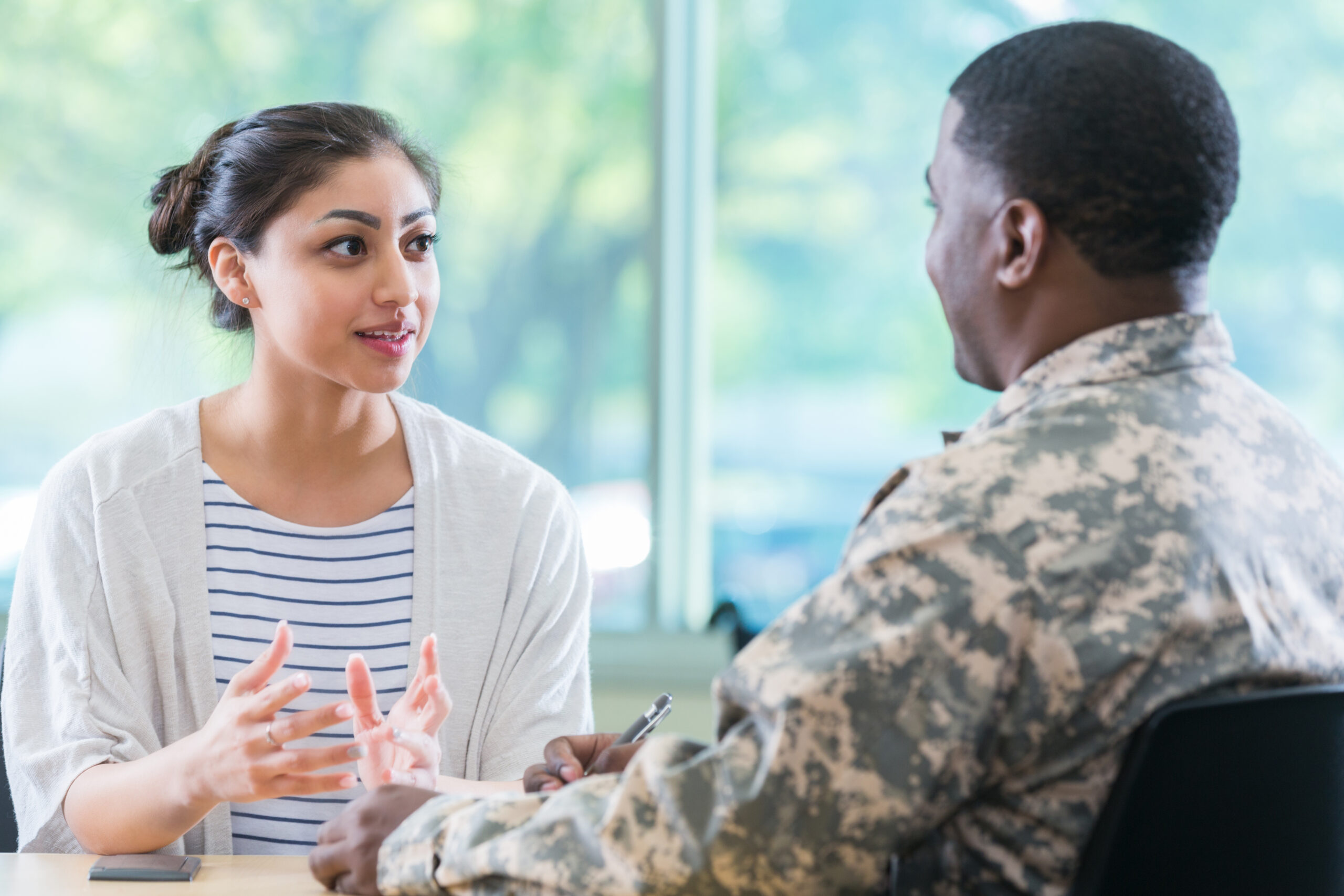 Customs, traditions, and manners are very important in the military. Each service has a set of values
that govern how each Service member approaches their work and personal life. These values are thoroughly indoctrinated during basic training and reinforced throughout their career. Military manners can be foreign, and may at times seem anachronistic (e.g., addressing individuals as sir or ma’am, deference to the chain of command). As a civilian working with the military, you should be aware of and respect these traditions.
Customs, traditions, and manners are very important in the military. Each service has a set of values
that govern how each Service member approaches their work and personal life. These values are thoroughly indoctrinated during basic training and reinforced throughout their career. Military manners can be foreign, and may at times seem anachronistic (e.g., addressing individuals as sir or ma’am, deference to the chain of command). As a civilian working with the military, you should be aware of and respect these traditions.
Here are some tips to support respectful collaboration with members of the military:
- Salutations: When addressing officers, address them politely, using sir or ma’am. Unless told otherwise, and always in public, military personnel should be addressed by their rank and last name (e.g., Seargent Brown, Colonel Sanchez). If you do not know their rank or last name, revert to using sir or ma’am.
- Reveilles and Retreats: When at an installation, you may hear a bugle call or the national anthem played. The two most important calls are for “reveille” and “retreat,” when the American flag is raised and lowered daily. When a Service member hears either of these calls, they will stop whatever they are doing to stand or salute. As a civilian, you are also expected to pause and stand quietly until the bugle call is done. If you’re driving with a Service member, see if you can safely stop or pull over so they can pay their respects to the flag.
- Salutes: A unique aspect of military courtesy is the salute. It is a gesture of respect and sign of comradeship among military service personnel. As a civilian, you are not expected to salute. However, if you are walking with a Service member, as a courtesy, you can stand or walk on their left side to make it easier for them to salute an officer that walks by.
Communication Style
The military favors succinct and authoritative communication – a necessity in war times. Do not be offended by short emails or brief communications:
- BLUF: Learn how to craft written communications using the military’s “BLUF” methodology (Bottom Line Up Front). The Harvard Business Review published an article about how to adopt this style of communication.
- Acronyms and Terms: Because of the brief communication style, the military has numerous acronyms and terms. The University of Nebraska’s Reserve Officers’ Training Corps (ROTC) provides a list of common military acronyms and terms. This list is by no means comprehensive. Each service has additional terminology. If an acronym is not on this list, perform a web search that includes the acronym and the service (e.g., “AFTB” and “Army”). If you do not know the service, use the acronym and the word military (e.g., “AFTB” and “military”).
Communicating with Military Public Health Groups
The Departments of the Army, Navy, and Airforce have public health corps embedded with their medical groups. These programs focus primarily on communicable diseases, hygiene, environmental health, and periodic health assessments. Although the term “prevention” is often used, in many cases it is in reference to violence prevention (e.g., sexual assault prevention, domestic violence prevention) or communicable disease prevention. Health promotion activities are typically directed at individual behavior change (e.g., improving sleep, physical activity, and nutrition, managing stress and pain, supporting healthy pregnancies).
As you communicate across the services, you may encounter position titles and program names that sound similar to the position titles and program names used in public health departments. Do not assume that they have the same functions. As an example, Hill Air Force Base employs a staff person called the Community Support Coordinator. This individual manages a Community Action Team that engages “helping agencies” to create a “community action plan” to address health trends in the “local community.” In this case, the community refers only to the local air force community and helping agencies are the other military-owned assets such as medical clinics and fitness facilities.
When communicating with military health and public health programs, ask a lot of questions about positions and programs to make sure you have a clear understanding of their activities. This will help you more accurately identify ways to support their efforts.
Crafting the Ask
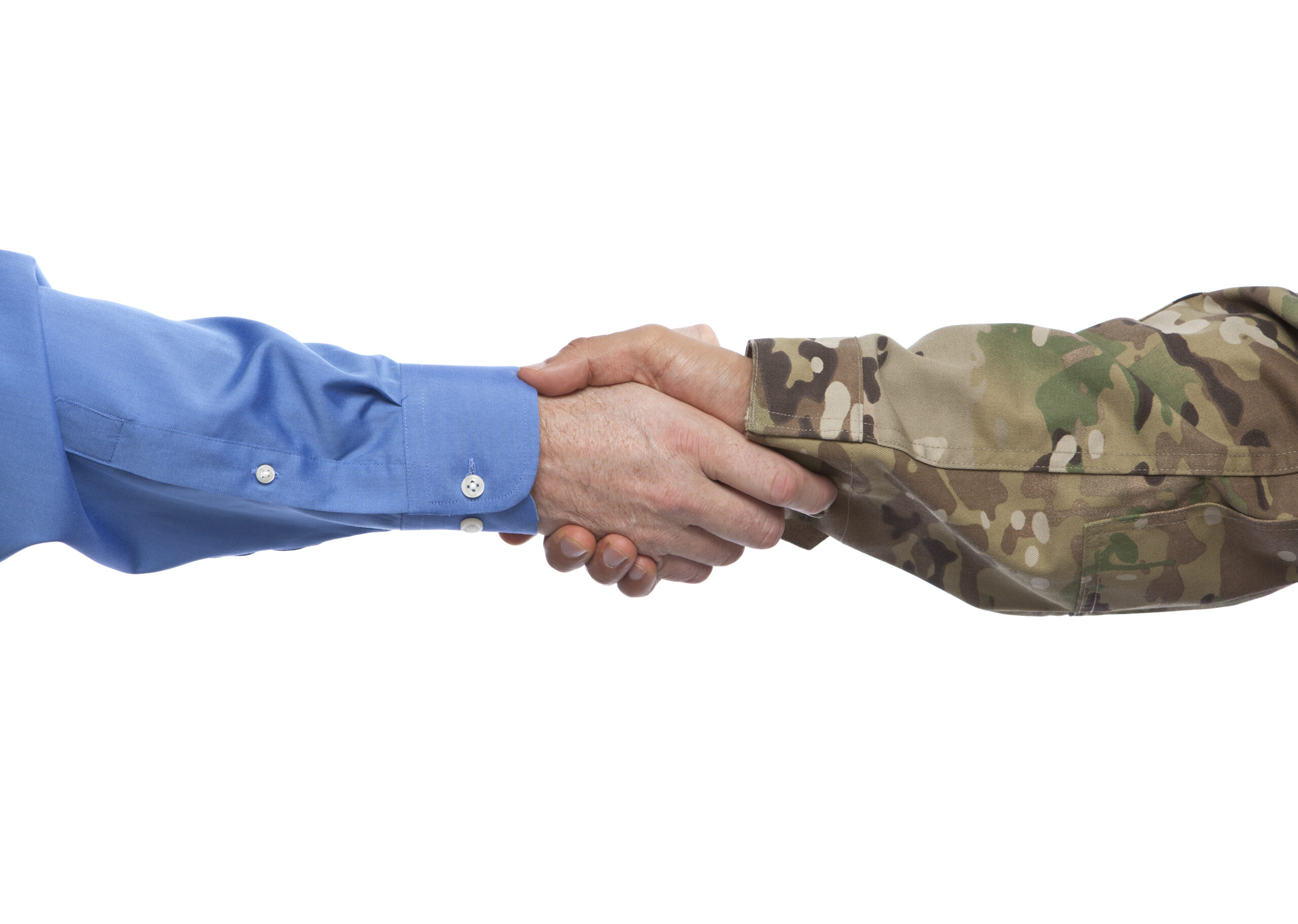 The military prides itself on self-sufficiency and teamwork. As such they do not often look “outside of the gates” or externally for solutions to problems. As you approach military partners for the first time, ask them what their primary needs are related to Service member health and wellness. Share health data from the community and ask your military partners if they are observing similar health outcomes among the military connected. Share with them the work you are doing to address the needs in the community (i.e., outside of the installation) and ask them about their programs and services for Service members and families.
The military prides itself on self-sufficiency and teamwork. As such they do not often look “outside of the gates” or externally for solutions to problems. As you approach military partners for the first time, ask them what their primary needs are related to Service member health and wellness. Share health data from the community and ask your military partners if they are observing similar health outcomes among the military connected. Share with them the work you are doing to address the needs in the community (i.e., outside of the installation) and ask them about their programs and services for Service members and families.
Ask how you can support their efforts to improve health both off and on the installation, and invite them to participate in health improvement planning efforts or other workgroups to ensure that the military voice is represented.
- For active duty, use the frame of readiness, retention, and resiliency to describe your health promotion work.
- For recruiters, connect the work you do with children and youth to increases in recruitable populations.
- For veteran groups, highlight how you and your partners’ services and programs contribute to veteran health and wellness.
Sample Introductory Email
Subject: MEETING REQUEST – State Department of Health Support for Readiness Efforts
Sir/Ma’am,
BLUF: The State Department of Health would like to meet with your team to learn more about how we can support military and family readiness.
BACKGROUND: Understanding that most military families live off-installation, our health department would like to adapt/expand our programming to ensure that the work we are doing in communities is tailored to the unique needs of Service members and their families. To do this, we would like to hear more from you about your goals related to readiness and how we can be a force multiplier for your efforts in the broader community. At your convenience, I would like to convene our teams to discuss.
Very Respectfully,

